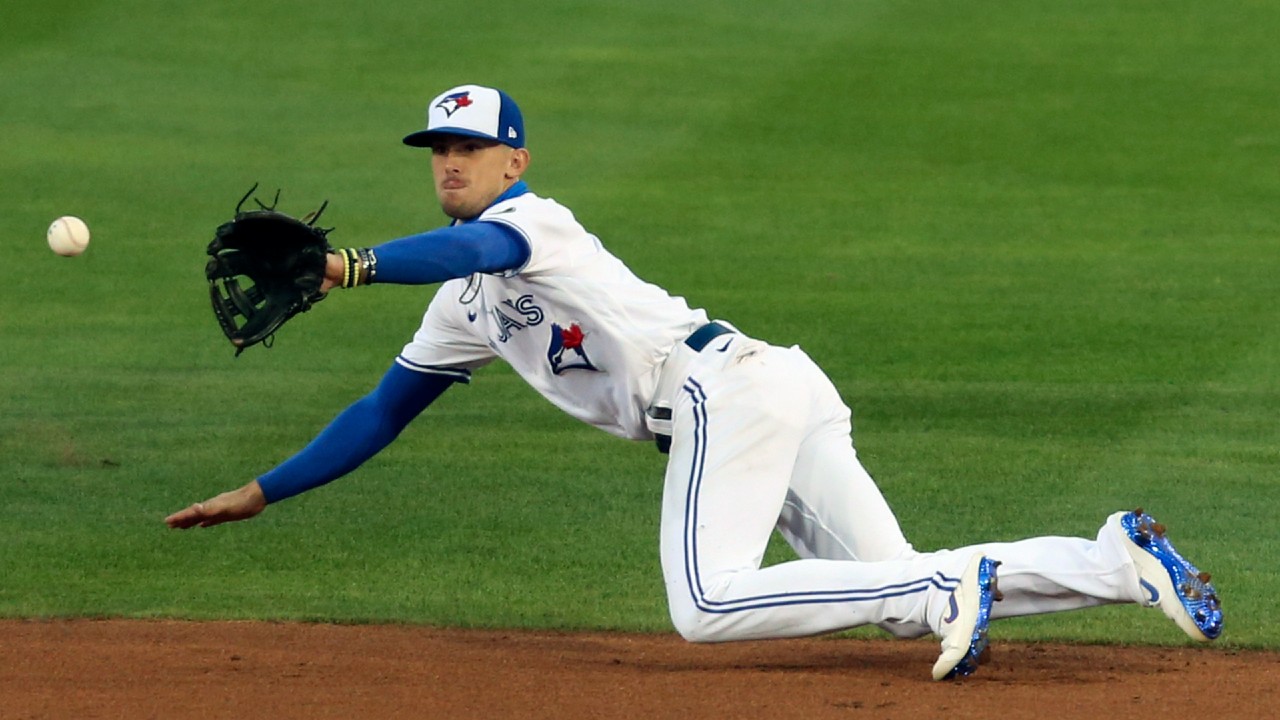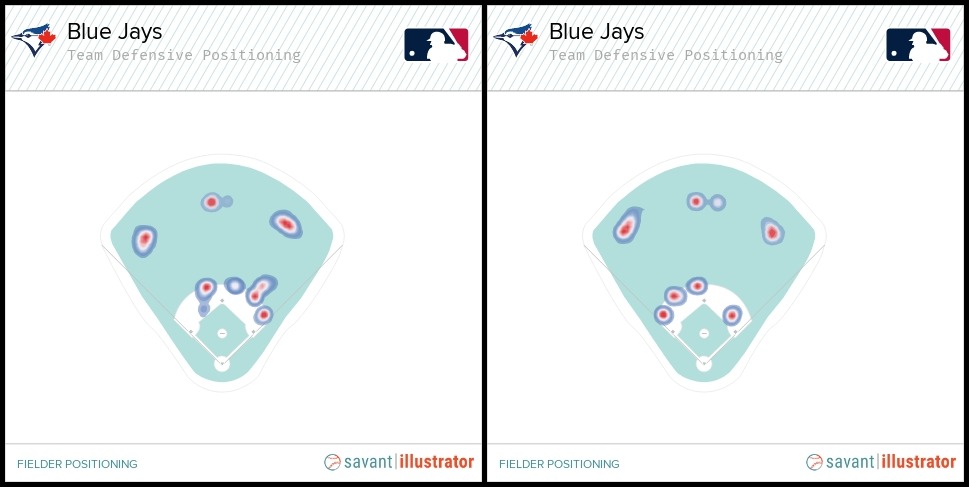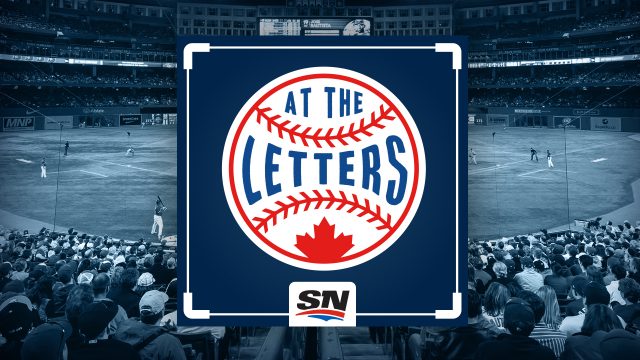
It isn’t truly spring training until someone gets hurt and someone else is trying to learn a new position. Fortunately for the Toronto Blue Jays, Thursday’s opening of camp in Dunedin, Fla. brought much more of the latter than the former.
Let’s start with who’s hurt. Patrick Murphy, the 25-year-old right-hander who made his MLB debut out of Toronto’s bullpen in 2020, has suffered a shoulder injury and will be sidelined for the beginning of camp. Blue Jays manager Charlie Montoyo didn’t specify the exact nature of the injury, when it occurred, or how long it’s expected to keep Murphy off a mound — only that he would be inactive while the rest of club’s pitchers ramp up for the season.
“We’re going to play it by ear,” Montoyo said. “Right now, he’s out for sure. Not for a long period of time. But we’re going to take it easy with him.”
Keen minor-league observers will be well aware of how frequently Murphy’s young career has been upended by preposterously bad luck. He’s already undergone procedures to reconstruct the ulnar collateral ligament in his throwing arm; to remove a rib that was thought to be causing thoracic outlet syndrome; and to address a pinched nerve in his elbow. Then, in 2019, amidst a strong double-A campaign that had him on the verge of making his major-league debut, Murphy’s toe-tap delivery was deemed illegal, forcing him to spend months overhauling his mechanics, which in turn led to season-ending shoulder fatigue due to over-work.
Murphy finally got back on track in 2020, impressed early in the season at Toronto’s alternate site, and earned a big-league call-up last September. He flashed his 97-m.p.h. fastball and biting, swing-and-miss curveball across four relief appearances, allowing a run over six innings, while striking out five and walking three. The intention this spring was to stretch Murphy back out as a starter — the role he served for his entire minor-league career — to provide triple-A rotation depth, although there was also an outside chance he’d end up helping the big-league club as a reliever if the Blue Jays wanted to carry more bullpen firepower.
Now, Murphy’s status for opening day is uncertain. But there’s no need to rush anything in mid-February. And especially considering his injury history, it won’t be surprising to see the Blue Jays progress Murphy cautiously over the next several weeks. The good news is all other Blue Jays pitchers and catchers reported to camp healthy, with the exception of Ross Stripling who will be a late arrival as he and his wife are expecting the birth of their child in the coming days.
Now on to the defensive positioning. Toronto’s front office has endeavoured for years to construct the kind of versatile, positionally-fluid roster that progressive franchises such as the Tampa Bay Rays and Los Angeles Dodgers have utilized to great success in recent years. It makes plenty of sense. If you roster several players capable of playing adequate defence at multiple spots, it gives your manager — or, perhaps more accurately, your analytics department — more options to optimize his lineup and exploit the weaknesses of the opposition. It also lets you tailor your defence to your starter, with groundball and flyball tendencies in mind.
Of course, having the right personnel is key. Players like Ben Zobrist and Marwin Gonzalez — above-average offensive contributors who could play a different position every day — were so valuable in their primes because they were so rare. It’s not an easy thing to do at such a high level of competition. That’s why the Blue Jays have been slow to implement their vision. Aside from Cavan Biggio, who played five different positions while posting a 122 OPS+ last season, the club has yet to develop a player in the Zobrist/Gonzalez mould.
But they’ll continue to try. That’s why Lourdes Gurriel Jr., who came up as a middle infielder and spent all of 2020 playing left field, will be getting reps at third and first base this spring. Likewise for Vladimir Guerrero Jr., who was exclusively a first baseman and designated hitter in 2020 but will play some third during camp. It’s why Marcus Semien will see time at both up-the-middle infield spots; why Teoscar Hernandez, George Springer, and Randal Grichuk will all take turns cycling through the three outfield positions; why Biggio will play all over.
“That’s what I like about our lineup,” Montoyo said. “We have so many options. Guys are going to move around.”
This is one reason why the various Blue Jays lineup projections you’ll see floating around social media at this time of year are a foolish exercise. The Blue Jays would ideally like to field a different lineup every day depending on health, form, and strategy. That extends to the batting order. Don’t expect to see hitters occupying the same slot on a nightly basis. Not even George Springer, the long-time Houston Astros leadoff hitter, who Montoyo expects to hit anywhere in his batting order’s top three positions.
“Of course he’s a good leadoff hitter, we all know that,” Montoyo said. “But what he said to me was he’s fine anywhere. He just wants to play and help. Which I love. When you get a guy like that who tells you that, it’s awesome.”
If you’ve been paying attention, none of this is a surprise. The Blue Jays used 56 different batting orders and defensive lineups over 60 games last season. Five different players led off; five hit second; eight hit third; and six batted cleaned up. The bottom of the order was even more fluid, as 11 different players hit sixth, while 15 apiece batted seventh and eighth. The days of Derek Jeter playing shortstop and hitting second every day for a decade straight are over.
Just look across the game. When more than a third of all plate appearances are played against a shift, what’s a position anyway? The images that follow account for every defensive plate appearance from Toronto’s 2020 season, with the positioning against left-handed hitters on the left, and right-handed batters on the right:

Whether a player’s listed as a second baseman, shortstop, or third baseman, he’s likely to be lining up all over the infield anyway. Some teams are regularly fielding four-man outfields. Semien may be playing second base this season for the first time since 2014, but it’s not like he hasn’t lined up on the right side of the infield plenty of times over the last several seasons. It’s one of the things that made him so attractive to the Blue Jays as a free agent this winter. He could play third in a pinch if circumstances necessitated it. In today’s game, versatility and flexibility is king.
To that end, spring training is the ideal time to figure out how much of it you have. The Blue Jays will spend the next several weeks experimenting with various roster constructions, taking looks at different players in different spots and seeking to determine what’s feasible come opening day. Nothing’s certain. Just because Guerrero plays a lot of third base in camp doesn’t mean he’ll be there too often — or at all — during the regular season. Just because Gurriel’s suddenly back on the infield for a few days doesn’t mean he won’t primarily be running out to left field come April.
But if those players do prove capable at third, it makes Montoyo’s life that much easier. It allows Biggio to move all over the diamond, which has been extremely valuable for the Blue Jays over the last two seasons. Guerrero playing third base once or twice a week would let Rowdy Tellez man first, which in turn frees up the DH spot for a player needing a day off his feet. Gurriel being capable of a game here and there at third would let the Blue Jays get outfielders Springer, Hernandez and Grichuk all in the lineup while preserving DH plate appearances for someone else.
And that versatility in general would make it easier to cover for injuries. If Bo Bichette were to miss time, Semien could slide over to short, Biggio could play primarily second, while a rotating cast of Guerrero, Gurriel, and others covered third.
Now, there’s certainly a line to be walked in terms of defensive quality, particularly when it comes to Guerrero, who was objectively MLB’s worst third baseman by Statcast’s Outs Above Average the last time he played the position in 2019. And, to a lesser extent, Gurriel, whose mechanical issues throwing the ball from second base necessitated his move to the outfield that same year.
Toronto’s minus-39 DRS last season was MLB’s second worst, and the subjective eye test confirmed the club’s pitching staff was often hard done by the defence playing behind it. The Blue Jays will likely produce a gang of runs this season with a loaded offence playing in a Dunedin bandbox, which can off-set some defensive deficiency. But the Rays showed the Blue Jays just how critical sound defence is for successful teams last September as they swept their division rival out of the post-season in two games.
Which is all to say, it’s one thing to play several positions — it’s another to play them well. But this is what spring training’s for, isn’t it? For repetitions, for experimentation, for trial and error. To assess your options, to find out what you have. And with a player already walking wounded, while several others try their glove hands in different spots, Toronto Blue Jays spring training is truly underway.






